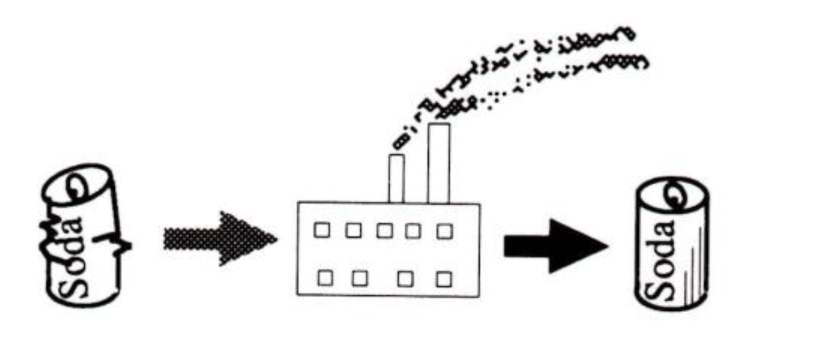Periodic gluts and shortfalls in the recycling industry aren’t a signal that recycling doesn’t work, says Donella Meadows. Such behavior is characteristic of any system that seeks a balance between supply and demand. And like other real markets, the adjustment process will involve time delays.
Contrary to conventional wisdom, Americans are proving not only able but willing to separate their garbage. In fact we’re becoming such ferocious recyclers that old newspapers are piling up by the ton with no place to go.
As the market for used newsprint crashes, some recyclers are getting discouraged, and some purveyors of conventional wisdom are saying, see there? Recycling just doesn’t work. There’s no market for it.
It would be more accurate to say we don’t know if recycling works; we haven’t yet tried it. When we do, gluts and scarcities will be signals not that there’s no market, but that the market is working the way it always works — in fits and starts.
What we are doing so far is separating, not recycling. We’re beginning to reclaim materials before they get to the dump. We have barely begun to close the loop — to reuse major materials in the same products: newspapers back to newspapers; plastic soda bottles back to soda bottles.

Product-to-same-product recycling is the only kind that can work in the long run.
Product-to-same-product recycling is the only kind that can work in the long run. Turning newspapers into cattle bedding will be helpful for a while, but eventually it will clog, either because we use newspapers faster than cattle bedding, or vice versa. Similarly the plastics industry is congratulating itself too soon for turning soda bottles into plastic flowerpots. Given the nation’s consumption rate of soda versus flowerpots one can easily predict a market collapse due to flowerpot glut.
What works is illustrated by the nation’s one smooth-running and economical recycling system—aluminum cans back into aluminum cans.
Even when newspapers are printed on recycled newsprint and the plastics industry makes new bottles out of old, there will be glitches, scarcities and overflows. These are inevitable in the evolution of any production system, especially one that is guided by the market. The only way the market can sense a large potential supply of something new is to let that something accumulate somewhere. The only way the market can stimulate a demand is to bring the price down low enough, and be sufficiently assuring about future supply, to stimulate new users.
In short, don’t let a temporary newspaper glut discourage you. We’re just at the beginning of a major industrial transformation. We’re working out a material-supply system consistent with a finite planet. It will be totally different from the wasteful, polluting system we have now — and it will take a while to get it right.
It’s worth keeping part of our attention cast ahead of the immediate economics to the place where we’re ultimately headed. A sustainable, economic, ecologically supportable materials system will re-use everything it can. It will add virgin materials only as necessary to sustain product quality. It won’t waste materials on unproduc-tive purposes such as packaging—it will use uniform and minimal packaging, standard bottles or boxes of standard sizes, interchangeable among products, for easy re-use. Only the label will distinguish the product.
” ..gluts and scarcities will be signals that the market is working the way it always works—in fits and starts.”
Marketers will have to attract consumers with a reason to buy their product that’s more important than glitzy packaging.
For easy recycling the use of mixed materials in manufacture (like the infamous squeezable ketchup bottle with seven different laminated plastics) will be discouraged. Products will be designed to last longer and be easily repairable. There will be thriving businesses that refurbish or recapture the components of large appliances. All this can be brought about simply by adding a tax to each product equivalent to the real cost of its disposal. That’s not distorting to the market, it’s correcting the market by adding a cost signal that should have been there all along.
When materials are finally so well used that they must be thrown out, they will be more carefully separated than they are today. First and most important, toxics — heavy metals, organic chemicals, radioactive materials — will not be allowed at all in municipal waste streams or sewage treatment systems. Toxics will go into entirely separate collection and disposal systems.
With the hazardous wastes out of the way, all organic wastes will be composted, along with sewage sludge. That single step will reduce garbage volume by 30 percent and provide tons of safe, free fertilizer. If glass, paper and metals are recycled, that would bring the garbage flow down to just 10 percent of what it is now. And that doesn’t include the possibility of recycling plastic.
No part of this dream system is impossible. Every piece of it is operating somewhere. Denmark has a model system for processing toxic wastes. The Netherlands has a massive composting system, as do many American cities. Technologies exist to reclaim paper, glass, metal and some plastics. Put them all together and we’d have the same material quality of life but with less mining, less air and water pollution, less traffic, less taxes, and 90 percent less stuff to haul to the curb every week.
Along the way toward a sustainable materials system — or any large social goal — there will be fits and starts, market failures, and disappointments. It’s worth hanging in there. We’re on the right track.
Donella Meadows is an adjunct professor of environmental and policy studies at Dartmouth College. She writes a weekly column for the Plainfield. NH Valley News.
